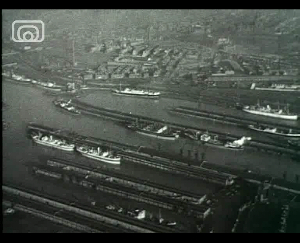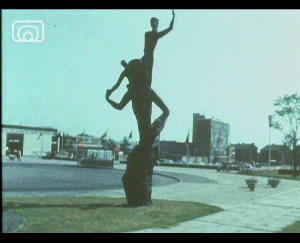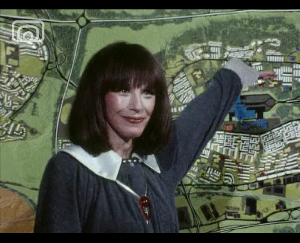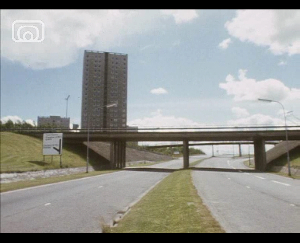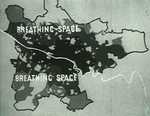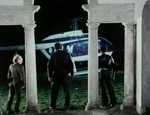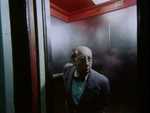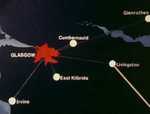Scotland's New Towns
- Introduction
- Lesson
- Film Clips
- Print All
Introduction
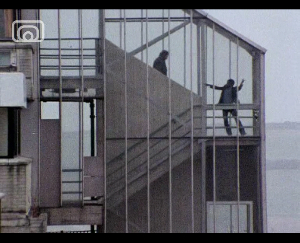
Five Scottish New Towns were designated between 1947 and 1966 (East Kilbride 1947, Glenrothes 1948, Cumbernauld 1956, Livingston 1962, Irvine 1966). The New Towns were an ambitious solution to build new communities and ease the problems of slum tenements and overcrowding in Scottish cities after WW2, particularly in Glasgow.
Lesson
Glasgow Today and Tomorrow
Glasgow Today and Tomorrow (7’58”)Background:
This promotional film Glasgow Today and Tomorrow was made to tie in with an exhibition of the same name at Glasgow's Kelvin Hall in 1945. The exhibition presented proposals made in the Bruce Report of 1945 to radically redesign and modernise Glasgow's housing and transport infrastructure. Robert Bruce was Glasgow's City Engineer and Master of Works from 1941-1948. He was behind two influential reports which proposed plans for a complete destruction of the existing Victorian city centre to create a new 'healthy and beautiful city' of modern architecture.
- What social and health problems were there in Glasgow because of slum tenements and overcrowding?
- How was the housing situation in Glasgow made worse as a result of WW2 and bombing raids by the German Luftwaffe during the Clydebank Blitz?
“A city of congested buildings and narrow roads.”
“A great population living in outmoded conditions which give rise to much confusion as well as discomfort.”
From the beginning the film uses strong and emotive language to emphasise why Glasgow needs to be modernised.
- What choice of words does the narrator use to emphasise these problems?
- What audience do you think the film has been made for?
- Who does it want to persuade?
- As you listen to the film make a list of the contrasting negative and positive words that the narrator uses to underline the message.
- How well does the choice of music, camera shots and editing reinforce the narrator's message?
Robert Bruce produced two reports which covered five key issues: transport, industrial growth, open spaces, redevelopment of blighted areas and provision for housing and commercial development.
- Can you find examples of some of these issues in the film?
- What reasons does the film provide for these problems?
- What proposals and solutions does the film present for these problems, specifically for transport and housing?
- Would any of the criticisms apply to Glasgow or other Scottish cities today?
The end of WW2 also spurred on the political movement for social reform and saw the creation of The Welfare State. The Beveridge Report, published in 1942, identified the five 'Giant Evils' in British society as; squalor, ignorance, want, idleness and disease. Clement Atlee's Labour government, elected in 1945, promised to eradicate these 'evils' and support families 'from the cradle to the grave.'
At 4'23” the film shows a clip of a family living in a classic single end Glasgow tenement.
“Such scenes as this are typical of the unsatisfactory conditions of thousands of people in Glasgow today.”
The narrator sounds shocked and appalled at the living conditions of the family.
“The Glasgow of tomorrow must see the elimination of all this.”
- Do you agree that the living conditions of this family are unacceptable?
- Is the narrator balanced in his opinions?
- Do you think the family would agree with the narrator?
- Do you think they had much say in where they would like to live?
- Pause on the different shots inside the house and discuss what each frame can tell us about the family and their living conditions.
- Compare this with the examples the film provides of good housing in Glasgow.
Beginning in the 1950s, Glasgow's clearance programme relocated some 750,000 of the city's population. New Towns such as East Kilbride and Cumbernauld were created as well as new urban housing schemes on the edge of the city such as Drumchapel, Easterhouse and Castlemilk. The film talks about building housing schemes with more 'breathing space'; modern houses, modern factories, recreational areas, community areas and better schools for children.
- Why are these crucial concerns for the city planners and also for the people and families who are being relocated?
- What difficulties do you think there were in relocating such a large proportion of Glasgow's population?
Look at the model of “the plans for the Glasgow of tomorrow” at 6'45”.
- Is this the Glasgow you would recognise today?
- How different is it compared to the aerial shots of the city shown at the beginning of the film?
The Bruce Report is regarded today as a controversial part of Glasgow's history. Not all of its radical ideas were carried out. The report also proposed to demolish the city centre and rebuild from scratch. This included the demolition of iconic Glasgow buildings such as the School of Art, the City Chambers, Central Station and other period architecture.
- Do you agree or disagree with the principles of the Bruce Report as presented by the film?
- Do you think that the measures carried out were successful in answering Glasgow's housing problems?
Activities
The narration excludes the opinions of the people who were being forced to move to the New Towns. Use the family shown at 4'23”. Script / act / film a drama bases around their thoughts and feelings. This could be done in a soap opera style or in a documentary style where the family are being interviewed and observed.
Use the archive clips to contrast and compare with images of Glasgow's housing and transport in the present day. Import clips or stills into Powerpoint or movie editing software to make a presentation of the results.
Create a survey and questionnaire to canvas opinion about improvements to the local area. Reflect on what way people's age, living conditions and job security might influence their opinions.
One of the criticisms of the new housing schemes was that they destroyed the old community ties and social habits of the tenements. Look at the lyrics of the Jeely Piece Song and The Glasgow I Used To Know by the famous Scots folk singer Adam McNaughton. How does he lament the Glasgow that existed before the modernisation? Write a unique song about your school or community.
You are given the opportunity to redesign your village, town, city centre or community. What improvements would you carry out? How radical would you be in preserving the past? You could present your findings in a number of ways by writing a report, giving a talk or making a film. A class could even take an enterprise approach and organise its own exhibition like the Kelvin Hall and invite parents, local politicians, shopkeepers, business professionals etc. to hear and see the proposals.
For more information about the Bruce Report take a look at Best Laid Schemes.
New Towns
New Towns (3’59”)Background
Green belts were created around Scottish cities to limit the urban expansion of cities and give the Scottish population access to the countryside. Therefore, one solution to the housing problem of the cities was to build New Towns outside of these areas. By 1966, Scotland had built five New Towns. The film New Towns reflects on the continued development and success of the Scottish New Towns.
The inspiration for the Scottish New Towns partly came from the social reformer Ebenezer Howard and the success of his Garden City Movement. He helped create Letchworth and Welwyn Garden Cities as an answer to the problems of London's overcrowding in the early Twentieth Century. Howard wished to create a utopia, an ideal world where man lives harmoniously together with the rest of nature.
- Was Howard successful in creating a utopian community with his Garden Cities?
- What is your idea of a utopian community? Is this a realistic ideal? Can everyone share the same utopian ideals?
- Do the images of the Scottish New Towns in the film match your impressions of a utopian community?
- Can you think of any stories, novels, poems, and films that present a perfect 'utopian' world in which you would like to inhabit?
This film adopts a different tone to the first film.
- Who do you think was behind the making of the film and who was the intended audience?
- How does the film language (e.g. use of music, narration, camera shots, graphics) compare or differ with the first film?
- What evidence does the film provide in how the New Towns are answering the problems of the old cities?
Glenrothes was built to ease the housing problems of both Edinburgh and Dundee.
- Why was the building of the Tay and Forth Road bridges so crucial in its success?
- Why were cars and road infrastructure at the heart of New Town planning? What transport measures would you include if designing a New Town in the present day?
Activities
Debate the concept of 'utopia.' Is the idea of an earthly paradise ever possible? Work together in groups to create a common idea of ‘utopia.’ Design a futuristic model community based on a set of values upon which you all agree. What innovations in lifestyle choices, materials and design will feature in your utopia?
Write a short story, or script a short film or animation set in a utopian society. Will it always stay perfect?!
Explore other utopian writing: 'Utopia' – Thomas More. 'Paradise Lost' – Milton. 'Island' – Aldous Huxley. 'Lost Horizon' – James Hilton
Cumbernauld Hit (clip 1)
Cumbernauld Hit (clip 1) (3’10”)Background (SPOILER!)
It is best not to know anything at all about this film before watching it! Cumbernauld Hit was a feature length fictional movie commissioned by Cumbernauld Development Corporation in 1977 as a promotional film for the New Town. The basic plot is a James Bond style thriller about an evil woman's (Leanna) plans to 'hi-jack' the New Town of Cumbernauld.
Listen to the clip with the screen covered until 2:15, just before Leanna gives the game away by saying 'Cumbernauld.' What clues does the soundtrack alone provide? (e.g. music, characters, setting, film genre and plot)
Watch the clip all the way through. Use a PPSS grid to organise your thoughts and ask questions.
Cumbernauld Hit (clip 2)
Clip: Cumbernauld Hit (clip 2) (5’20”)
The film Cumbernauld Hit makes heavy use of character stereotypes and slapstick humour.
Activities
Can you find some examples of these stereotypes from both clips? Make a list and discuss some of your own favourite stereotypes (e.g. crazy scientists, super villains, dumb stooges, silly police, ace newshounds) from films, comics, books etc.
Leanna likes to use some unusual vocabulary and a lot of alliteration! Make a list of her more peculiar words or sayings from watching both clips. Come up with some new Leanna style sayings.
The pineapple house shown in the film is a National Trust property and folly at Dunmore House, some 12 miles away from Cumbernauld itself!
- Remembering that the movie was made to promote Cumbernauld, how well does it manage to sell the New Town?
- Do you think this film would attract investment, new industries and families to move to Cumbernauld?
- Does it make you want to live in Cumbernauld?
- Is the film 'Cumbernauld Hit' or 'New Town' better at selling and marketing the concept of New Town living?
Look at the chase scene from 3’08” to the end of the clip.
Activities
Watch and discuss what different film techniques are used to film and edit the chases sequence. Think about the different types of music, the use of sound effects, comedy slapstick moments and overacting through facial expressions and physical movement.
Pause and restart the sequence to storyboard the camera shots and camera movement. Perhaps visit the Moving Image Education website. Compare the sequence with clips from classic slapstick films by Buster Keaton, Charlie Chaplin or Laurel and Hardy. What elements make a really good film chase sequence? Compare and contrast with discussion and/or clips from films like The French Connection, The Bourne trilogy and the Bond films.
Create an advert or tourist film for your school, community or local area. Choose a specific film genre as the basis for your plot.
Download Clip 2 and re-edit the chase sequence with new music sound effects. Act, script and film your own chase sequence.
Use one of the characters from the film, like Leanna, and create a comic book strip based on what their next crime caper might be after hi-jacking Cumbernauld.
Gallimaufrey - A Cumbernauld Poem
Gallimaufrey - A Cumbernauld Poem (2’37”)Background
Gallimaufrey is a poem reflecting on the success of the communities created by the New Towns. Gallimaufrey - A Cumbernauld Poem uses a montage of clips of New Town scenes to illustrate the words. At first it is unclear whether the poet and narrator is in favour of New Town living and appears to present an objective analysis of the merits of New Town planning. However, when the poet speaks directly to camera for the first time with a wry smile saying, “I sometimes fancy a wee riot,” it is clear that he is not convinced by a future world as seen through the eyes of New Town planners.
In contrast to the utopian ideal of New Towns as presented by Ebenezer Howard, the poet mentions two key titles of works of dystopian fiction. Dystopia is the opposite of a utopian ideal and presents a totalitarian and repressive vision of the future. The opening and closing lines of the poem refer to Aldous Huxley's 'A Brave New World' and George Orwell's “Nineteen Eighty-Four" . Other examples of dystopian fiction include Margaret Atwood's “A Handmaid's Tale” and the films “A Clockwork Orange”, “Brazil” and “Britannia Hospital”.
- Watch the film until 2’00”. Discuss whether the poet is in favour or against New Town living. What case does he make for both?
- How does the tone of the poem change when we see the poet? Why is this significant?
- How are the images and clips used to narrate the poem? Make a note of what you see next to each line of the poem? Does the imagery present the New Town lifestyle in a positive or negative light?
- The poet often uses great Scots words like breenge, stramash and hing to describe the old way of life, in contrast to words like concrete, hygienic and zoned which are used to describe the New Town. Why are his selection of words and the way they sound important in setting the slightly sarcastic tone of the poem?
- At the end the poet pessimistically throws in the towel when he says, “I'll keep the peace and shut the door, and wait for 1984.” He seems to be saying that he does not want to be controlled by planners and government but there is little he can do to protest. Do you agree with poet?
Activities
Write a poem about your school, family or local community. Take photographs, create artwork or record film clips to illustrate your poem.
Combine the sounds and images using Powerpoint or movie editing software.
Write a dystopian science fiction story which is set in a futuristic version of your school or community.
Links
A more animated take on the New Towns from a 1940s Public Information film: Charly in New Town.
The classic Scottish comedy of teenage angst, Gregory's Girl, is set in the New Town of Cumbernauld.
This lesson guide was prepared by primary schoolteacher Athole McLauchlan.
